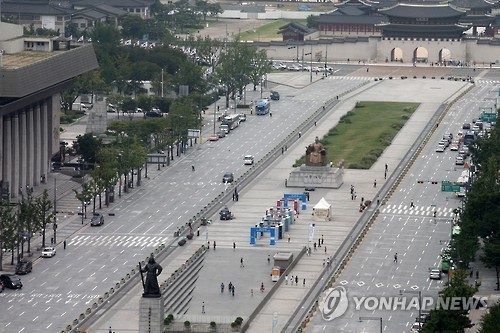Seoul Metropolitan Government plans to create an underground passage to connect major tourist attractions in central Seoul, the mayor said Tuesday.
Seoul Mayor Park Won-soon said that the underground path would link Seoul City Hall, Deoksugung Palace and Gwanghwamun Square, to recreate the city’s historic Yukjo Street leading to Gyeongbokgung Palace.
The underground pathway will house exhibition centers, cultural venues, museums, restaurants and shopping malls.
 |
Gwanghwamun Square in central Seoul (Yonhap) |
“Currently, Gwanghwamun Square does not serve as a square. It has only become a massive median strip (separating opposing lanes of traffic),” Park said in a meeting with reporters.
The city will push to turn the traffic lanes in front of Sejong Culture and Art Center into part of Gwanghwamun Square and only open the lanes in front of the U.S. Embassy to vehicles.
The plan is strongly opposed by the central government, citing possible traffic congestion and safety issues surrounding Cheong Wa Dae and the U.S. Embassy.
Residents in the neighborhood also object to the scheme, saying that expansion of the square will further cause noise and traffic congestion. The square is frequented by foreign visitors, while also acting as a walking trail for commuters and office goers in the area as well as a popular venue for large-scale rallies.
“Expanding Gwanghwamun Square does not cost much. We need more fundamental leadership from the central government,” the mayor Park said.
The mayor also revealed the city’s long-term plan to restore Yukjo Street of the Joseon Dynasty in Gwanghwamun Square leading to Gyeongbokgung Palace. The street had been home to six major government edifices.
The city will reinterpret Yukjo street in a “modern” way and construct a three-story building running through Gwanghwamun Square, the mayor said. The first floor will be cleared for pedestrians to freely walk around, while the second and third floors will have shops and cultural venues.
By Ock Hyun-ju (
laeticia.ock@heraldcorp.com)







![[Today’s K-pop] Blackpink’s Jennie, Lisa invited to Coachella as solo acts](http://res.heraldm.com/phpwas/restmb_idxmake.php?idx=644&simg=/content/image/2024/11/21/20241121050099_0.jpg)
